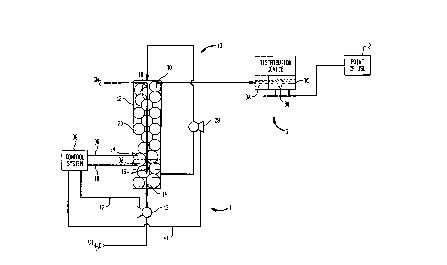Some of the information on this Web page has been provided by external sources. The Government of Canada is not responsible for the accuracy, reliability or currency of the information supplied by external sources. Users wishing to rely upon this information should consult directly with the source of the information. Content provided by external sources is not subject to official languages, privacy and accessibility requirements.
Any discrepancies in the text and image of the Claims and Abstract are due to differing posting times. Text of the Claims and Abstract are posted:
| (12) Patent: | (11) CA 2248910 |
|---|---|
| (54) English Title: | DISPENSING SYSTEM AND METHOD FOR DISPENSING AN AQUEOUS SOLUTION |
| (54) French Title: | SYSTEME ET METHODE DE DISTRIBUTION DE SOLUTION AQUEUSE |
| Status: | Expired and beyond the Period of Reversal |
| (51) International Patent Classification (IPC): |
|
|---|---|
| (72) Inventors : |
|
| (73) Owners : |
|
| (71) Applicants : |
|
| (74) Agent: | GOWLING WLG (CANADA) LLP |
| (74) Associate agent: | |
| (45) Issued: | 2002-04-23 |
| (22) Filed Date: | 1998-10-02 |
| (41) Open to Public Inspection: | 1999-05-26 |
| Examination requested: | 1998-10-02 |
| Availability of licence: | N/A |
| Dedicated to the Public: | N/A |
| (25) Language of filing: | English |
| Patent Cooperation Treaty (PCT): | No |
|---|
| (30) Application Priority Data: | ||||||
|---|---|---|---|---|---|---|
|
A system and method for dispensing an aqueous solution to one or more points of
use is provided with one or more pressure vessels that are adapted to be charged with
pressurized gas to drive the aqueous solution on to the point or points of use. A humidifier
is also employed to humidify the pressurized gas to at least inhibit the pressurized gas
from evaporating the moisture from the aqueous solution. In such manner, changes to the
make up of the aqueous solution are avoided. Such changes can produce caking and/or
changes in chemical properties found in pressure vessels used in dispensing slurries.
Note: Claims are shown in the official language in which they were submitted.
Note: Descriptions are shown in the official language in which they were submitted.

2024-08-01:As part of the Next Generation Patents (NGP) transition, the Canadian Patents Database (CPD) now contains a more detailed Event History, which replicates the Event Log of our new back-office solution.
Please note that "Inactive:" events refers to events no longer in use in our new back-office solution.
For a clearer understanding of the status of the application/patent presented on this page, the site Disclaimer , as well as the definitions for Patent , Event History , Maintenance Fee and Payment History should be consulted.
| Description | Date |
|---|---|
| Inactive: IPC expired | 2012-01-01 |
| Inactive: IPC deactivated | 2011-07-29 |
| Inactive: First IPC derived | 2010-02-01 |
| Inactive: IPC from MCD | 2010-02-01 |
| Inactive: First IPC derived | 2010-01-30 |
| Inactive: IPC expired | 2010-01-01 |
| Time Limit for Reversal Expired | 2006-10-02 |
| Inactive: IPC from MCD | 2006-03-12 |
| Inactive: IPC from MCD | 2006-03-12 |
| Letter Sent | 2005-10-03 |
| Grant by Issuance | 2002-04-23 |
| Inactive: Cover page published | 2002-04-22 |
| Pre-grant | 2002-02-07 |
| Inactive: Final fee received | 2002-02-07 |
| Letter Sent | 2001-08-08 |
| Notice of Allowance is Issued | 2001-08-08 |
| Notice of Allowance is Issued | 2001-08-08 |
| Inactive: Approved for allowance (AFA) | 2001-07-27 |
| Inactive: Cover page published | 1999-05-31 |
| Application Published (Open to Public Inspection) | 1999-05-26 |
| Amendment Received - Voluntary Amendment | 1999-01-12 |
| Inactive: IPC assigned | 1998-12-30 |
| Classification Modified | 1998-12-30 |
| Inactive: First IPC assigned | 1998-12-30 |
| Inactive: Filing certificate - RFE (English) | 1998-11-13 |
| Filing Requirements Determined Compliant | 1998-11-13 |
| Application Received - Regular National | 1998-11-09 |
| Request for Examination Requirements Determined Compliant | 1998-10-02 |
| All Requirements for Examination Determined Compliant | 1998-10-02 |
There is no abandonment history.
The last payment was received on 2001-09-20
Note : If the full payment has not been received on or before the date indicated, a further fee may be required which may be one of the following
Please refer to the CIPO Patent Fees web page to see all current fee amounts.
| Fee Type | Anniversary Year | Due Date | Paid Date |
|---|---|---|---|
| Request for examination - standard | 1998-10-02 | ||
| Application fee - standard | 1998-10-02 | ||
| Registration of a document | 1998-10-02 | ||
| MF (application, 2nd anniv.) - standard | 02 | 2000-10-02 | 2000-09-20 |
| MF (application, 3rd anniv.) - standard | 03 | 2001-10-02 | 2001-09-20 |
| Final fee - standard | 2002-02-07 | ||
| MF (patent, 4th anniv.) - standard | 2002-10-02 | 2002-09-19 | |
| MF (patent, 5th anniv.) - standard | 2003-10-02 | 2003-09-22 | |
| MF (patent, 6th anniv.) - standard | 2004-10-04 | 2004-09-21 |
Note: Records showing the ownership history in alphabetical order.
| Current Owners on Record |
|---|
| THE BOC GROUP, INC. |
| Past Owners on Record |
|---|
| BENJAMIN R. ROBERTS |
| DUY KHANH TRANG |
| PETER M. POZNIAK |